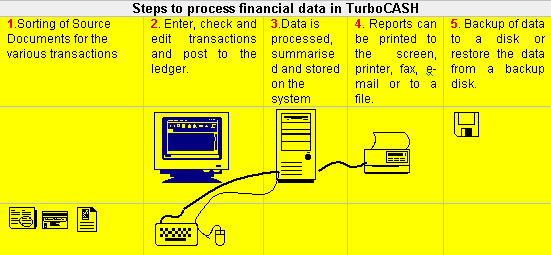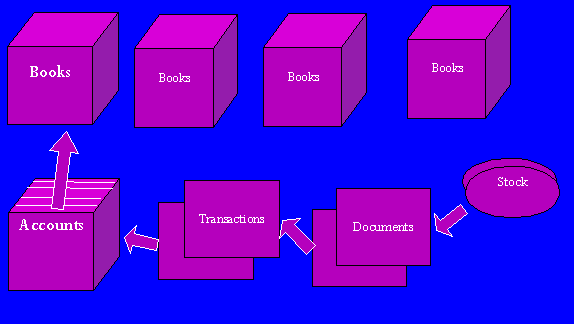
TurboCASH is very easy to set up and to use. You only need to set up a set of books once, create your master records, some defaults, and process your transactions. You may then at any time generate a host of reports to manage your financial activities.
TurboCASH provides you with a user- friendly graphical interface, which allows you to perform most functions with a few mouse clicks and a little typing. When you are in certain fields, search facilities are available where you only need to select the details of a transaction or the selection criteria of a report, etc. The steps to process financial data in TurboCASH can basically be illustrated as follows:

The structure of TurboCASH in which the financial data is processed, stored and reported on is as follows:

The TurboCASH File System
Sets of Books
TurboCASH allows you to keep up to 999 sets of books. A set of books is a set of computerised files on which all the financial data are entered, processed, summarised and reported for a business entity or an organisation. The full accounting records for a business entity or an organisation are kept in a set of books. You may create a set of books for any entity for which you wish to manage and monitor its financial activities.
TurboCASH stores each set of books in a separate directory or folder on your system. The list of these Sets of Books is kept in the books.db file (database file) in the TurboCASH Program Directory. Each set of Books must have approximately 40 Paradox Files. TurboCASH uses the Borland Database Engine (BDE) to read these files.
Company Information, defaults and settings
For each set of books the entity's information (Company information) and defaults or settings are stored. The information will be reflected on reports and the defaults or settings will be used to enter, process and to report on the data.
Accounting Periods
Any entity needs to report on their financial activities (financial performance and financial position) for a specific period. The activities are usually measured over a financial year. The financial year is further divided into accounting periods. This is usually the month (12 periods) in a financial year, representing the calendar months. All the transactions of an entity must be recorded in the accounting period in which the transactions occurred.
The accounting periods are used to generate reports on the transaction data. TurboCASH stores the totals and other financial information for up to 2 years. This will allow you to compare your reports for this year and last year.
The file totals.db contains period totals for each period (Usually 12) for this year and last year. These act as a cross-reference for balancing the set of books. The totals for any period for accounts must balance to zero, as a transaction must have a debit and a credit of equal value. Debits are positive numbers and Credits are negative numbers.
Accounts
The core to a Set of Books is the Chart of Accounts. This data is kept in the accounts.db file. There are 5 types of Accounts files, which contain fields of information specific to each type of file:
General Ledger Accounts - Assets, Capital, Liabilities, Income or Expense accounts.
Bank Accounts - Cash book payments and receipts batch.
Creditor Accounts - Creditor contact information, remittance advise messages, credit limits, charge amounts, tax references, groups, etc.
Debtors Accounts - Debtor contact information, statement messages, credit limits, charge amounts, interest percentage, tax references, groups, etc.
Tax Accounts - Percentages for VAT and effective dates in which these percentages apply.
Stock items
If you are trading in stock items, TurboCASH stores specific data of your stock items in the Stock.db file. This data would include codes, descriptions, selling prices, and bar codes, tax accounts, sales, cost of sales and stock account information.
Transactions
All transactions are entered in batches and these batches are posted to the ledger. The information of each transaction is kept in the Trans.db file. This information would include the batch type, the date and period of the transaction, reference number, description, amount, tax amounts, account and contra account.